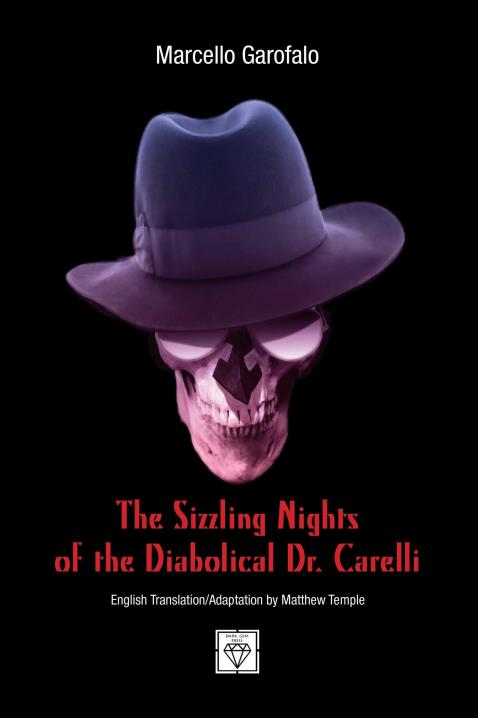
“The reader, can for himself, easily imagine everything on a big screen (…) To persuade and to entertain (yes, to entertain!) him are not only the sharp manor of writing, or the imaginative situations presented or some surprising references of literature that reveal a refined taste, but the fact that “The Sizzling Nights of the Diabolical Dr. Carelli is moreover an intellectual work that is unbending to conformism; so far away, from the “old fashion” ambitions of other writers”
“Horror/Comedy with a great visual potential filled with surrealistic threads (…) the perfect balance of “tributes” and “affective memories,” from Roger Avary to John Carpenter, without forgetting our beloved Fulci and James Whale’s Frankenstein. Starting with chapter titles that could have been used for the most splendid films never made, the writer adopts the process “a la Tarantino” that shuns the quote as an end unto itself and becomes the grammar of a new textual foundation (…) In these pages, we see the evolution and pleasure of unbounded storytelling.”
“A cinematic novel, to devour madly: anarchist, a swing away from the ordinary, a revolution for a (dying) editorial planet. Toccata and Fugue in D minor that meets David W. Griffith. (…) The Diabolic Dr. Carelli conquers the ‘Universal Soul’ at the end of his jouney, exactly like Pinocchio the “wooden boy”, or Noodles with a smile at the end of Sergio Leone’s last movie.”
“This book is a movie, a horror movie that is already a classic. Encyclopedic, eclectic, with the dry language of a comic-strip, and as a consequence more American in its tradition, than European, Garofalo ”presents” the facts and nothing else. He does not lose himself in artificial or affected ornaments that slow the pace. He is essential. Direct. He describes the temperaments of his characters as if drawn on the page in two dimensions, on a ”path” that runs between one genre and the other, he crosses back and forth with pleasure and mastery, and more than just a pinch of humor”
“Art films, B-Movies, Disney, Noir Comics, Music, and Literature: the imagery of Garofalo feeds on his love of movies and so much more. The result of this passion is an eccentric tale that reads like a graphic novel and excites like Fulci’s horror movies. Walking dead, complementary Chinese twins, female mad scientists, super villains, bungling heroes, and perverse top model and professor populate a story far from any conformism in which the grotesque, the erotic and cinephilia merge, ensnaring the reader like a garrote”.
“The novel is an unexpected, rippling pulp fiction, an extremely original comedy, full of amazing, surprising characters, that seem to support the stereotypes of the genre but to the contrary, turn them upside down”
“The book, written in language both ‘Shakespearian and a bit cartoonish’ is irreverent and exhilarating and it’s already a movie (…)The protagonist is the diabolical Dr. Carelli, an all-bone zombie, killed at the age of 19 and returned to life to overturn the claim to fame of the monster, and do justice and provoke a revolution. Garofalo is a master of metamorphosis, who sharpens words like weapons of the unusual and bizarre (…) An explosion of unlimited creativity, that evokes the journey of Alice in Wonderland…”
“The Sizzling Nights of the Diabolical Dr. Carelli” is more than a title it’s a “manifesto”. Marcello Garofalo directs all his knowledge, as an expert of “Cult Pics”, with some quick side glances to the comics and a lot of humor. The result is a rip-roaring novel (…) but don’t expect an excessive play of quotes. In Garofalo’s novel it is the taste for the plot that prevails, beyond each abstraction or intellectual instance, because the movie references are cleverly hidden within the intricacies of the plot without burdening it (…) Between the imaginative and surreal plans of action, the “monster” and his author, .0delight in demolishing all the “cliché” of the horror genre.”
“A movie born as a book. Every page a new screen capturing and holding your attention (…) It sets a relentless rhythm with a wise use of sarcasm that enriches this literary genre (…) A fairy tale for adults set is a world Far West of the soul, to be read or seen (…) A sort of “film on paper” at once amusing and terrifying”.
(…) Even the title of this novel evokes the classic films of Jess Franco, but far beyond that it is a splendid, playful “melting pot” of erotic fantasy and ironic cine-lit. It expresses bits of reality with film quotes that are never an end unto themselves, but used as a narrative pretext in a deliberately labyrinthine plot: e.g., the animated scenes of the films “Brazil” (1985) or “Sin City” (2005) (…) Garofalo’s writing is deliberately “beyond”, “multitasking”, with lightning lines that could have easily come out of a script by the Coen brothers, and just as easily be transposed to the cinema or adapted to a graphic novel.
“Perversely suspended between horror and comedy (…) and imbued with a cinephilia that is never banal, or excessive, the novel by Garofalo also surprises with its ability to bring out, between the lines of terse and explicit dialogues, all the sense of humor and culture of its author, as well as his taste for the unusual, the bizarre, the marginal (…)”
“Kaleidoscopic, ironic, cult, cinephile without haughtiness, astonishing novel by Marcello Garofalo, “The Sizzling Nights of the Diabolical Dr. Carelli” is like a graphic novel married to a novel, a B-Movie on paper (…) Reading the book, you’ll surf between many movie genres, often on the borderline, without never being “caged” in any of them and you’ll laugh a lot, recognizing quotes, some more evident than others.”

































 Studied Biochemistry, Computer Engineering & History
Studied Biochemistry, Computer Engineering & History












